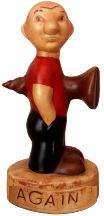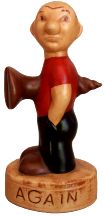 |
 The Virtual Corkscrew Museum's Weekly Newspaper |
 |
 |
 The Virtual Corkscrew Museum's Weekly Newspaper |
 |
|
Sunday, February 11, 2007 |
New Extant American Patent Corkscrew Found
by Mark Woodard
I was walking through my local antique mall recently and I spotted a Clough wire corkscrew with wooden sheath. The sheath advertised "Underhay Oil Co., / P.H. / Auto Oil / Boston." It was in nice condition and priced at a mere $2.00, so I picked it up, paid for it, and stuck it in my coat pocket.
When I returned home, I took the item out of my pocket and was about to toss it into a drawer with a few dozen other Cloughs, but I decided to take another look at it. What I saw was quite surprising. The butt end of the wooden sheath was recessed, and in the recess was a small metal point, much like the tip of a nail.
I had never seen a Clough corkscrew sheath like this before, so I grabbed my copy of Ron MacLean and Bob Nugent's book, William Rockwell Clough, Inventor and Manufacturer of over a Billion Corkscrews, to see what this strange spike was. Much to my surprise, I did not find any mention of this type of sheath in Ron's book. I emailed Ron some pictures and I expected the "Corkscrew Fountain of Knowledge" to tell me exactly what it was. He too was stumped. The only clue was a somewhat worn patent marking in small letters on the sheath. The best I could make out was "???G CO., WALTHAM, PAT. JUNE 2, ?90?"
I checked Fred O'Leary's invaluable book on American patents, Corkscrews: 1000 Patented Ways to Open a Bottle, and found this patent drawing on page 234. It matched my corkscrew and sheath exactly. Eureka!
On June 2, 1908, the USPTO issued utility patent # 889,556 for a "Cigar Tip Perforator". The inventor was not William R. Clough, but another familiar name - Augustus W. Stephens. He lived in Waltham, Massachusetts and it was there that he ran the Stephens Manufacturing Company. Stephens patented and manufactured a variety of bottle openers, corkscrews, and the like during the early part of the 20th century (see Corkscrews by Fred O'Leary and Just For Openers by Don Bull and John Stanley for patent references.) The sheath that I found shows the word "WALTHAM", suggesting that it was manufactured at the Waltham location. I now knew that I was holding an example of Augustus Stephens' patented variation of a Clough corkscrew sheath. Yet there is no photograph of an extant corkscrew of this type in Fred O'Leary's book, suggesting that it is a rare find. This gives all of you American patent corkscrew collectors something new and interesting to hunt for, or as Fred says, "It will also complicate life for collectors attending antique shows and flea markets. No longer will we be able to pass by a junk display case without looking at every sheath."
In his patent specification, Stephens refers to the patent drawing and states "[item] f represents a perforating device or pin, the shank of which is firmly imbedded in the body a', the pointed outer end of the pin projecting into the cavity e, so that it is adapted to penetrate a cigar tip inserted in said cavity." He also describes the sheath as having "…a handle portion which enables it to be readily manipulated, and is at the same time adapted to serve as a storage receptacle for another article, such as a cork screw, the whole being adapted to be carried in the pocket of the user."
You can view the full online patent specification here .
So I posed the question to Ron and Fred, "Would there have been a cooperative effort between Clough and Stephens to produce these special sheaths?"
Ron replied, "I agree there may have been some connection between Stephens & Clough who certainly manufactured the corkscrew and could have made the sheath perforator as well? I wish I had known before as it really belonged in the Clough book. It will be interesting to discover who else/how many who have found the same item. I was not aware of its existence, surprised that Bob Nugent had not found one, perhaps it was not manufactured in great numbers."
Fred replied, "I found no examples in my travels to photograph for the book. At least I found the patent, which is a good example of why I researched ALL patents, rather than just those classified as corkscrews. I surely would have missed it (and many others) had I stuck to the classification system.
"As to the Clough-Stephens connection, or lack thereof... What I know from the patents and tools themselves -- not recorded history -- is that Clough marked his plain wood sheath corkscrew with the 1900 patent, which was for his corkscrew making machine. There was no mention of a sheath in the drawings or specifications -- all 12 pages of them. Clough's 1910 patent talks only of a bottle cap lifter (the 'Decapitator') as an attachment to or modification of a wood sheath, much as Stephens' cigar perforator is also an adaptation of a generic wood sheath. Clough's was intended to hold a corkscrew. Stephens was not committed to a corkscrew -- it could be "another article". Both had different mind sets and both piggybacked on the wood sheath, which was considered a given.
"Both Stephens and the 1910 Clough patent applications overlapped. Clough applied Oct. 16, 1907; Stephens less than a month later on Nov 8. Stephens, however, got to the finish line in less than 7 months; Clough's relatively equally simple concept took over two years. There could be a simple explanation for this -- application technicalities, reviewer backlog, illness, vacations, etc., so no great meaning should be attached to the disparity in approval time.
"If one concludes there is no connection to be found in the patent documentation or process or in the marking of the sheaths, on the other hand, the similarities and short distance between Waltham, Mass and Alton, N. H. cannot be overlooked. Surely these two guys had to know what the other was up to vis a vis the patent office, and especially with Stephens using the Clough corkscrew. It is no stretch to surmise they got together on making sheaths. There just isn't any evidence of it... yet."
So did Clough manufacture the Cigar Tip Perforator sheaths, was it a cooperative effort, or did Stephens simply purchase the wire corkscrews from Clough and make the sheaths himself? It is unclear, but the circumstantial evidence seems to point to the latter - that the sheaths were made solely by Stephens. I'll present the evidence below and let you be the judge.
The most significant piece of circumstantial evidence is Stephens' "All-Ways" combination opener. The All-Ways included a sheathed Clough wire corkscrew and the handle of the All-Ways is typically marked "A. W. Stephens Mfg. Waltham Mass." This suggests that Stephens had the capability to manufacture wooden sheaths in his Waltham factory, perhaps as early as 1901. So when it came time to make the Cigar Tip Perforators, it seems only logical that Stephens would have manufactured them in-house also.
The Cigar Tip Perforator sheath is marked with the Stephens' factory location of Waltham - another strong indication that it was made in Waltham, not Alton.
The Stephens patent states that the sheath may be used to keep "other articles" besides a corkscrew, and he specifically mentions that "The extension a may be used for holding toothpicks or other articles usually carried in the pocket, a suitable stopper being provided for closing the mouth of the cavity b." There may be examples of Stephens toothpicks cases out there as well (I don't know of any toothpick case collectors to ask!) If Stephens did make sheaths for other purposes, he certainly would have done it in-house as well. I'm sure that Clough had no interest in producing toothpick cases and the like.
There are dramatically fewer Cigar Tip Perforators than Decapitators extant, suggesting that Clough had no vested interest in making the Cigar Tip Perforators, else we surely would have found many more of them. It seems that production of the Stephens sheath must have been very brief.
Unless some contrary evidence comes to light, I think we must conclude that Clough's only involvement was to provide the corkscrews for the Cigar Tip Perforator, much as he supplied Stephens with the corkscrews for the All-Ways.
To complete this story, I need your help. Please take a look at every one of your wooden sheathed corkscrews and check to see if any of them include the Cigar Tip Perforator. If you find any, email me (mark22gg@yahoo.com) and describe any markings on the sheath. Look for an update in a future edition of The Weekly Screw.
Author's Note: I would very much like to thank Fred O'Leary, Ron MacLean, Josef L'Africain, and Don Bull for their assistance in preparing this article.
Editor's Note: Mark Woodard is an engineer with NASA based in Maryland. Mark is an avid corkscrew collector and is currently working on a book about the inventor of the crown cork (William Painter: Inventor and Industrialist).
Patent Search
Mark Woodard and a number of other corkscrew collectors are now using the new Google patent search engine. On the website over seven million U. S. patents can be searched using key words. Using the advanced search allows the user to select a number of variables.
The patents were evidently added to the website using OCR technology. As a result, users are apt to find some errors in listings. For example, on the page for Harry Vaughan's U. S. Design Patent D46762 the inventor name appears as Harry L. Vattghan. Nevertheless, this is an excellent research tool.
An terrific site for researching international patents is the German website depatisnet.de.
Readers are encouraged to research corkscrews and to submit articles to The Weekly Screw.
Anonymous Postcard
Apparently intrigued by the "corkscrew trees" featured in recent issues, an anonymous reader mailed a huge postcard to The Weekly Screw.
The card, like the tree, is huge. It measures 4" x 10".
The postmark is San Jose, California.
Also curious is that we received an anonymous letter to the editor:
Dear Editor:
I enjoyed the photos of corkscrew trees in recent issues. I am fairly new to this hobby and, frankly, I was not aware that corkscrews grew on trees.
However, there are none visible on the corkscrew trees so I suspect these photos were all taken during the off-season. Or they had been harvested early by over zealous collectors.
Do you have any photos showing corkscrews actually growing on trees?
Very truly yours,
Unsigned
Editor's response: Welcome to this twisted hobby. Your question is answered in the photo below.
Not only are corkscrews growing on this tree but bottles are as well.
|
©2007 Don Bull, Editor |